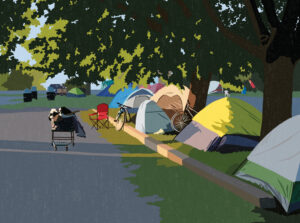
People & Culture
Kahkiihtwaam ee-pee-kiiweehtataahk: Bringing it back home again
The story of how a critically endangered Indigenous language can be saved
- 6310 words
- 26 minutes
This article is over 5 years old and may contain outdated information.
People & Culture

People often remark that it’s ironic the only mountain left unsummitted in the Yukon’s Centennial Range is Mount Saskatchewan.
But that’s why Jeff Dmytrowich, Wren Rabut, Sam Unger and I — all of us from the flat lands of Saskatoon — were set on being the first to reach it.
We’re not the first to try. Since 1967, three teams have attempted to summit Mount Saskatchewan, which is around 2,500 metres shy of Canada’s highest peak. So with a nod to our predecessors, we decided to start our climb on a glacier around 6,000 feet (around 1,800 metres) high — the same starting altitude as the first team’s attempt in ‘67.
Once we were on the ground, what had appeared from the helicopter as mere wrinkles in the glacier became crevasses up to six feet (two metres) wide and 80 feet (24 metres) deep. How do you tiptoe around that kind of danger when you’re wearing snowshoes and carrying 75 pounds (34 kilograms) on your back? It’s physically and emotionally exhausting.
Nevertheless, we made good progress on our first day, reaching 7,500 feet (2,300 metres). On our second day, we had to choose between climbing the avalanche slope or facing the jungle of hazards that was the icefall. We ended up climbing only 500 feet (150 metres) up the icefall that day, and decided to take the avalanche slope from then on. We had to climb at night, since avalanche danger is lowest when the temperature drops. During the day, the snow heats up and starts shifting, and avalanches start at around 2 p.m.
We started climbing at 11 p.m. and made it up another thousand feet (300 metres) by 1:30 a.m., all the while enveloped in a soupy grey fog. I couldn’t even see everyone tied to the rope. I dropped some gear while I probed the glacier — I thought we were in the middle of the upper bowl, but there was no way I could be sure. We flagged our cache and returned to our temporary camp at the base of the icefall, rested for a couple of hours while the fog lifted and then trudged the rest of the gear up the slope back to 8,500 feet (2,590 metres). It turned out we’d found the perfect drop spot and designated it our high camp. This was where we’d begin our first summit strike.
We set out at 2 a.m. the next night. We established an anchor at 10,500 feet (3,200 metres) after plowing through the snow, which was less firm than we would’ve liked, and navigating our way around crevasses. I ended up getting pulled out three times.
The weather threatened to turn so we decided to head back for high camp and try again after getting some rest. We reached our anchor quickly the next night and began a series of attempts on various pitches working up the mountain. But the rock only got worse, and the snow was so sugary you could barely step in it.
We went one direction and couldn’t establish any additional anchors. We went another way, got up a little higher; we tried another way and again got a little higher. We got to the point where we’d exhausted every line, and we needed to think about getting back down to high camp for food and rest.
We rappelled down to our original anchor and then climbed down to the base of the col at 9,700 feet (3,000 metres). At that point, it was 1 p.m., and we knew our time was running out — the avalanches would start soon. I started walking down the slope when a slab of snow beneath my feet went WHOOMP. The others quickly pulled me back up, and we changed our game plan. We decided to dig a snow trench and wait for slope to firm up. We had some food and tea, exchanged high fives all around and relished our break.
About an hour into our wait it started to snow. At this point we were six days into our climb, and little did we know that the snow wouldn’t let up anytime soon.
This post is part of a series. To read other posts by this author, click here.
Are you passionate about Canadian geography?
You can support Canadian Geographic in 3 ways:

People & Culture
The story of how a critically endangered Indigenous language can be saved

People & Culture
For unhoused residents and those who help them, the pandemic was another wave in a rising tide of challenges

Places
In Banff National Park, Alberta, as in protected areas across the country, managers find it difficult to balance the desire of people to experience wilderness with an imperative to conserve it

People & Culture
The death of an unhoused Innu man inspired an innovative and compassionate street outreach during the nightly curfew in 2021